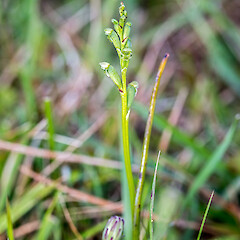Microtis oligantha
Common name
small onion orchid
Synonyms
None (first described in 1967)
Family
Orchidaceae
Flora category
Vascular – Native
Endemic taxon
Yes
Endemic genus
No
Endemic family
No
Structural class
Orchids
NVS code
The National Vegetation Survey (NVS) Databank is a physical archive and electronic databank containing records of over 94,000 vegetation survey plots - including data from over 19,000 permanent plots. NVS maintains a standard set of species code abbreviations that correspond to standard scientific plant names from the Ngä Tipu o Aotearoa - New Zealand Plants database.
MICOLI
Chromosome number
2n = 44
Current conservation status
The conservation status of all known New Zealand vascular plant taxa at the rank of species and below were reassessed in 2017 using the New Zealand Threat Classification System (NZTCS) – more information about this can be found on the NZTCS website. This report includes a statistical summary and brief notes on changes since 2012 and replaces all previous NZTCS lists for vascular plants.
Please note, threat classifications are often suggested by authors when publications fall between NZTCS assessment periods – an interim threat classification status has not been assessed by the NZTCS panel.
- Conservation status of New Zealand indigenous vascular plants, 2017 . 2018. Peter J. de Lange, Jeremy R. Rolfe, John W. Barkla, Shannel P. Courtney, Paul D. Champion, Leon R. Perrie, Sarah M. Beadel, Kerry A. Ford, Ilse Breitwieser, Ines Schönberger, Rowan Hindmarsh-Walls, Peter B. Heenan and Kate Ladley. Department of Conservation. Source: NZTCS and licensed by DOC for reuse under the Creative Commons Attribution 4.0 International licence.
2017 | Not Threatened
Previous conservation statuses
2012 | Not Threatened
2009 | Not Threatened
2004 | Not Threatened
Distribution
Endemic. New Zealand: North Island, South Island, Chatham Islands.
Habitat
Damp places in tussock grassland, on lake, tarn, river and wetland margins. Coastal to subalpine. Mainly montane to subalpine in the North Island, descending to sea level in the South and Chatham Islands
Wetland plant indicator status rating
Information derived from the revised national wetland plant list prepared to assist councils in delineating and monitoring wetlands (Clarkson et al., 2021 Manaaki Whenua – Landcare Research Contract Report LC3975 for Hawke’s Bay Regional Council). The national plant list categorises plants by the extent to which they are found in wetlands and not ‘drylands’. The indicator status ratings are OBL (obligate wetland), FACW (facultative wetland), FAC (facultative), FACU (facultative upland), and UPL (obligate upland). If you have suggestions for the Wetland Indicator Status Rating, please contact: [Enable JavaScript to view protected content]
FAC: Facultative
Commonly occurs as either a hydrophyte or non-hydrophyte (non-wetlands).
Detailed description
Terrestrial, glabrous, fleshy, tuberous bright green to dark green perennial herb forming small colonies or occurring as solitary plants. Plants at flowering up to 150 mm tall. Tubers globose to ovoid. Stem erect, terete, fleshy. Leaf solitary, usually overtopping inflorescence (but often damaged and so falling short), bright green to dark green, rarely tinged with red near base, closely sheathing stem for much of length, linear-terete, hollow, up to 200 mm long. Inflorescence a loose raceme up to 30 × 5 mm. Flowers 1–10, up to 2.8 mm diameter, shortly-stalked mostly widely spaced. Perianth green, segments up to 1.8 mm long, widely spreading, thick and fleshy. Dorsal sepal 2.5 mm long, broadly ovate, erect or projecting forwards, cucullate, concave, column-embracing, apex and margins rounded (without recurved apex), smaller than ovary at flowering. Lateral sepals much shorter, narrower, mostly acute to subacute, strongly deflexed, apices straight. Petals shorter again, broadly to narrowly obtuse, erect, mostly hidden under dorsal sepal. Labellum sessile, up to 2.0 mm long, green or yellow-green, oblong, slightly narrowed at mid-length; apex bluntly truncate rarely slightly emarginate, not apiculate; margin papillose, shallowly crenate, often thickened, rarely undulate; anterior callus variously developed, verrucose, rather irregular, often raised on a rounded ridge; basal calli conspicuous, dark green, tabular-ovoid to tabular, usually continuous at sides with narrow band of callus behind a transverse, slit-like (not pouched) furrow; labellum sharply deflexed, pendulous aligned more or less parallel to the ovary. Column short, obtuse, base of column mostly broader than stigma, wings mostly membranous throughout. Anther terminal, erect, situated above stigma, hemispherical, pollinia spheroidal, pollen granular. Stigma broadly ovate; rostellum ovate Capsules broadly ovoid, ovoid-ellipsoid, brown when ripe.
Manaaki Whenua Online Interactive Key
Similar taxa
Usually smaller than the other species of Microtis and with fewer flowers (up to 10). This species is best recognised by the obtuse rather than acute dorsal sepal whose apex is not upturned, and by the short-oblong to almost quadrate labellum with only shallowly crenate or rarely undulate margins. The labellum calli are indistinct and tabular.
Flowering
December–March
Flower colours
Green
Fruiting
March–May
Propagation technique
Easily grown in a damp sunny position. Should not be removed from the wild.
Etymology
microtis: Tiny eared
oligantha: Few-flowered
Where To Buy
Not commercially available
TAXONOMIC NOTES
Chatham Island plants tend to be much larger than those seen on the other New Zealand islands.
Attribution
Fact Sheet prepared for NZPCN by P.J. de Lange 14 April 2007. Description adapted from Moore and Edgar (1970).
References and further reading
Moore LB, Edgar E. 1970. Flora of New Zealand, Volume II. Indigenous Tracheophyta: Monocotyledones except Gramineae. Government Printer, Wellington, NZ. 354 p.
NZPCN Fact Sheet citation
Please cite as: de Lange, P.J. (Year at time of access): Microtis oligantha Fact Sheet (content continuously updated). New Zealand Plant Conservation Network. https://www.nzpcn.org.nz/flora/species/microtis-oligantha/ (Date website was queried)








